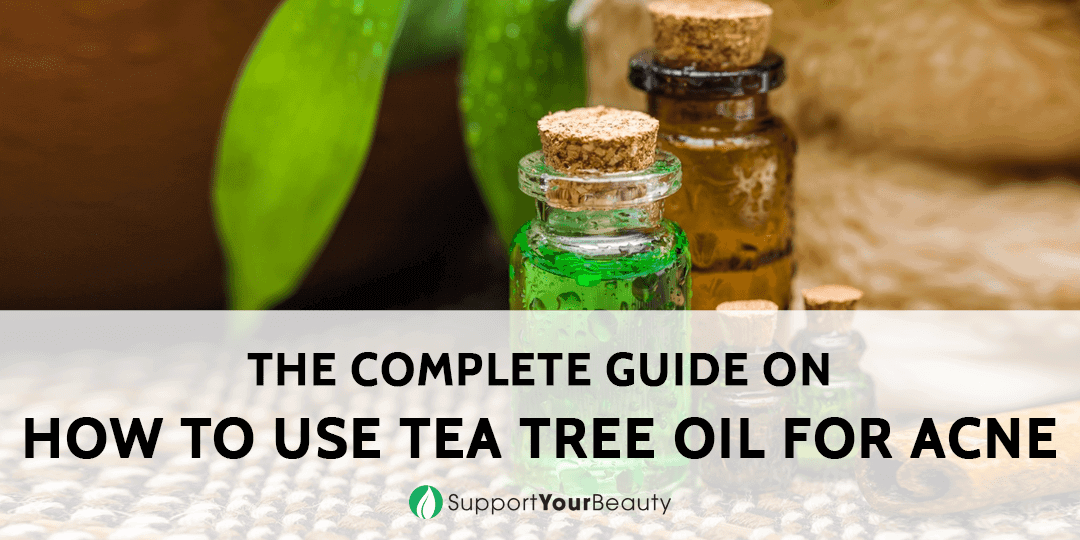
Are you looking for the best ways on how to use tea tree oil for acne? Revealing what no one tells you about the little-known tricks!
At a Glance: Known as “nature’s miracle healer,” tea tree oil is an all-around natural remedy for various health and beauty concerns, especially for treating acne.
Perhaps, in one of your trips to the skin care aisle of the supermarket, you’ve come across entire shelves of tea tree oil products—and you have for good reason!
From shampoo to foot soak, tea tree oil helps heal various ailments of the body.
However, we guess that what you are mostly interested in is how to take advantage of tea tree oil to solve your acne problems.
While there are many other products that your dermatologist can prescribe for you or you can buy over-the-counter, they will most likely hurt your wallet.
And, although there are many natural remedies you can concoct at home, we understand that you're probably worried about their safety and efficiency.
So, your best bet to treating acne naturally and keeping it from returning once more is to utilize the amazing benefits of tea tree oil.
Not only is it safe, but tea tree oil is also proven to significantly help heal breakouts, diminish acne scars, and help maintain that smooth, acne-free skin you dream of.
More...
How is Tea Tree Oil Produced?
Let us first give you a background of its origins.
Tea tree oil is an essential oil produced from the Melaleuca alternifolia tree, which is indigenous to New South Wales in Australia.
More commonly known as the Narrow-leafed paperbark, its leaves are harvested every twelve months.
The leaves are then placed in a rainwater-filled boiler where they are heated by wood and distilled at a high temperature.
This process of distillation separates the oil from the water and produces 100% tea tree oil.
Uses Of Tea Tree Oil Throughout The Centuries
Indigenous Australians were the first to use the leaves of the Narrow-leafed paperbark tree for their unique healing components.
They would crush the leaves and apply them directly onto cuts and wounds to avoid infection.
Over time, the Narrow-leafed paperbark became known as tea tree because European settlers in Australia would brew the leaves to make a spicy tea drink.
It was in the early 1920s when Australian chemist, Dr. A.R. Penfold, conducted a study of tea tree leaves.
Dr. Penfold’s studies concluded that the antiseptic bactericide properties of the tea tree essential oils were 13 times stronger than carbolic acid.
What Does Tea Tree Oil Do For Skin?
Tea tree oil has since gained popularity for its medicinal properties and, while it is useful in treating many different kinds of health issues, we will focus on its benefits for your skin.
The most active component of tea tree oil is terpinen-4-ol, which is an organic compound that is found in a variety of plants and is the building blocks for essential oils.
Terpinen-4-ol gives tea tree oil its anti-bacterial, anti-fungal, and anti-microbial properties.
Thanks to terpin-4-ol, you can use tea tree oil to cure different skin infections, one of which is acne.
How Can It Help You?
Acne is a common skin condition that affects most people at some point in their lives. So, if you are bombarded with breakouts, don’t worry, as you’re not alone.
While 80% of acne sufferers are adolescents and young adults, 20% of adults are not spared from it.
Acne starts when your skin’s sebaceous glands (oil glands) produce too much sebum (oil), which is mixed with dirt and dead skin cells and blocks the tiny openings for hair follicles known as pores.
Depending on the severity of your acne breakout and how you treat it, scarring may occur.
That’s why, at the first signs of an acne breakout, your task is to get it under control as soon as possible.
This is where tea tree oil comes in the picture. Tea tree oil works by countering the microbial causes of acne.
The bacteria Propionibacterium acnes grows deep inside the pores and feeds on sebum.
An overgrowth of these bacteria contributes to the development of acne by increasing the production of sebum that causes the formation of acne lesions (pimples, comedones, etc.).
What tea tree oil does is kill off these acne-causing bacteria, especially when they have become resistant to regular acne antibiotic medications.
And because tea tree oil has anti-inflammatory properties, it can help reduce the skin’s inflammation caused by acne.
Finally, tea tree oil helps dry out excess sebum from the skin; thus, regulating, if not stopping, new acne lesions from developing.
How to Use Tea Tree Oil For Acne
Before you jump on the tea tree oil bandwagon and prepare your own anti-acne solutions, let us first guide you on which tea tree oil to use.
Remember: Tea Tree Oil is a Topical Solution
If you are wondering what could possibly be the best method of using tea tree oil for acne, here's our word of advice: You must never confuse "natural" with "non-toxic/poisonous."
Despite its rather self-effacing name, tea tree oil is poisonous if swallowed and should, therefore, only be used as a topical solution.
Determine Which Tea Tree Oil to Use
Thinking of which tea tree oil to use?
While you will most likely come across many different brands, you must choose a bottle of tea tree oil that is in its truest, purest form.
Here’s how you can get the best tea tree oil product:
1. Check the label for its terpinen percentage
You can determine the purity of tea tree oil based on its concentration of terpinen-4-ol. It should range between 10% and 40%.
Remember that the higher the percentage of terpinen, the stronger its antiseptic properties.
2. Observe the color of its glass container
Remember those old medicine bottles that your grandparents used to have?
Tea tree oil should be repackaged in similar dark brown glass bottles because, when the oil is exposed to light, its terpinen-4-ol will rapidly oxidize, rendering it useless.
Exposure to light may also cause tea tree oil to increase the levels of p-cymene, a known skin irritant.
3. Consider how much of it is actually tea tree oil.
Sure they smell great, but what about the quality?
Some manufacturers combine tea tree oil with other essential oils, thus affecting their potency.
4. Organic Is the Way to Go
We’ll leave it to you on whether to go organic or not, but keep in mind that tea tree oil that is 100% organic offers higher terpinen-4-ol concentration.
The Best Recipes
Now that you know which tea tree oil to use for that perfect anti-acne solution, it’s time that you learn different recipes for your own little concoction.
As tea tree oil is extremely potent, it will work best with other natural ingredients in clearing your skin of acne once and for all.
Most of the ingredients that we included in this list of recipes are readily available at your local supermarket or holistic food store.
Not everything in our list may react positively for you, though, so take the time to carefully consider each ingredient depending on the condition of your skin.
1. Stand-alone solution
Why it works:
If you have mild acne, you can try applying tea tree oil directly on your pimples.
The natural antibacterial properties of tea tree oil will effectively penetrate your skin to remove excess sebum and dirt while killing off the bacteria that aggravates acne.
As it is a bit greasy, however, you might want to include this in your bedtime routine instead of your morning rituals.
Preparation:
- Wash and dry your face, then pour a couple of drops of tea tree oil on a cotton bud
- Dab it on your pimples; make sure that you cover the entire area
- Leave overnight for best results
2. Oatmeal scrub
Why it works:
Unlike readily available acne scrubs, natural homemade ones are not as abrasive in removing dead skin cells.
Vigorous scrubbing of the skin can only exacerbate the condition of your acne.
When added with tea tree oil, a natural ingredient like oatmeal is a gentler substitute that can cleanse your skin from impurities and minimize the appearance of acne lesions because of their anti-inflammatory properties.
Preparation:
- Mix equal parts of ground oatmeal and water. You can also use raw honey for a thicker consistency
- Add two to three drops of tea tree oil and mix all the ingredients well
- Gently lather the skin with the scrub and leave it on for at least 20 minutes
- Rinse off with warm water
3. Tea tree oil toner
Why it works:
Commercially manufactured toners may be too harsh on your skin.
Most drugstore toners are alcohol-based which can strip your skin of its natural moisture, making it dry and crepey.
Mixing tea tree oil with raw apple cider vinegar produces a gentle, exfoliating solution that will remove dirt, oil, and bacteria while restoring the natural pH balance of your skin.
It will also help your skin to keep acne at bay because it creates an acid mantle which acts as a natural barrier against pathogenic bacteria.
Preparation:
- Prepare a 3-ounce spray bottle, combine one part tea tree oil and one part apple cider vinegar with three parts water
- After washing, spray it directly on your face, but be careful around your eye area
- Leave to dry
4. Spot-on treatment
Why it works:
When treating acne, “spot-on” solutions offer a more potent concentration of the active ingredients that would have otherwise covered the entire face.
You can prepare a spot-on treatment by mixing tea tree oil with aloe vera or raw organic honey.
Aloe vera and raw organic honey complement the antibacterial properties of tea tree oil and help promote the healing process of the skin.
Preparation:
- In a small container, mix two teaspoons of aloe vera or raw organic honey with two to three drops of tea tree oil
- Apply this mixture on the pimple and allow it to dry
5. Clay mask
Why it works:
Masks provide intensive moisture while absorbing excess oil from your skin.
By spreading the entire formulation on your face, the masks deliver an equal concentration of the antioxidant, anti-inflammatory, and anti-acne properties of tea tree oil.
For added skincare efficacy, you can combine tea tree oil, jojoba oil and green clay powder.
Preparation:
- Prepare your face mask by mixing two tablespoons of green clay powder with water until it forms into a soft paste
- Mix the paste with two drops of tea tree oil and two drops of jojoba oil
- Apply the mask evenly on your face and neck and leave it to dry for at least 30 minutes
- Rinse off with warm water and pat dry
The Bottom Line
There it is, folks – your complete guide on how to use tea tree oil for treating acne.
One bottle, that’s all it takes to clear your skin of acne with tea tree oil.
And because you can turn tea tree oil into almost any kind of beauty solution, it also gives a lot of bang for your buck!
Tea tree oil’s antibacterial and anti-inflammatory properties keep pores from becoming infected with acne-causing bacteria.
As nature’s miracle healer, tea tree oil not only helps reduce several acne symptoms but also diminishes acne severity.
A natural ingredient that is as powerful as other industrial anti-acne chemicals, tea tree oil is your safest and easiest route to clear, acne-free skin. Best of all you'll avoid the redness, drying, and peeling other products can bring!

